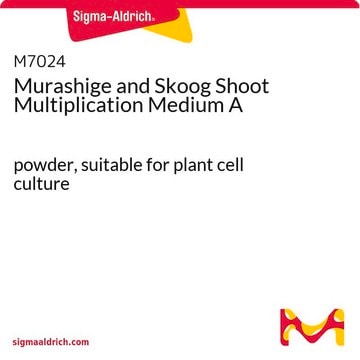The Murashige and Skoog media products have not been tested for conductivity.
M0404
Murashige and Skoog Basal Medium
powder, suitable for plant cell culture, with Gamborg′s vitamins
Synonym(s):
MS0 Medium, MSO Medium, Murashige and Skoog (Gamborg Modified) Basal Media, MS Basal Medium
Select a Size
About This Item
Recommended Products
Quality Level
form
powder
technique(s)
cell culture | plant: suitable
application(s)
agriculture
shipped in
ambient
storage temp.
2-8°C
Looking for similar products? Visit Product Comparison Guide
Application
Formula variant
Media Formulation
Quantity
Preparation Note
Murashige and Skoog medium (M0404) contains the macro- and micronutrients of M&S basal medium as described by Gamborg, et al (1968). It can be supplemented with organics and with auxins (IAA) and cytokinins (Kinetin) to generate a complete medium for growth plant tissue culture.
Signal Word
Warning
Hazard Statements
Precautionary Statements
Hazard Classifications
Eye Irrit. 2 - Ox. Sol. 3
Storage Class Code
5.1B - Oxidizing hazardous materials
WGK
WGK 2
Flash Point(F)
Not applicable
Flash Point(C)
Not applicable
Choose from one of the most recent versions:
Already Own This Product?
Find documentation for the products that you have recently purchased in the Document Library.
Customers Also Viewed
-
What is electric conductivity of Murashige-Skoog culture solution?
1 answer-
Helpful?
-
-
I would like to know if there is any problem in irradiating with UV light, media culture prepared with the medium.
1 answer-
Testing protocols for plant culture media include sterilization by autoclaving. Heat-labile components are filter-sterilized and added after autoclaving, prior to asceptic dispensing to sterile vessels. UV sterilization has not been investigated as a sterilizing technique for culture media products, although this does appear to be growing in popularity. Keep in mind that UV would not melt agar used in solid media formats. Autoclaving or boiling would still be required. Please see the link below for a publication that may offer additional information:
https://pubmed.ncbi.nlm.nih.gov/25044686/#:~:text=Ultraviolet%20(UV)%20irradiation%20is%20a,sterilization%20of%20cell%20culture%20media.Helpful?
-
Active Filters
Our team of scientists has experience in all areas of research including Life Science, Material Science, Chemical Synthesis, Chromatography, Analytical and many others.
Contact Technical Service












